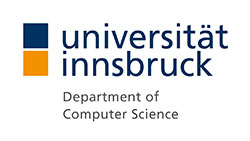Research is the core task of STI Innsbruck. Our motto is "Enabling Semantics". Find out more about our current research directions!
Archive
This page lists the current projects with STI Innsbruck. Please see the archive and the historical projects for more on completed projects.
Service Austria: Research and Industry Dissemination (SARID) After four decades of rapid advances, computing is currently subject to revolutionary changes at all levels, including hardware, middleware, network infrastructure, but more importantly artificial intelligence. Emerging technologies as the Semantic Web and Web services transform the Internet from an information network into a network of knowledgeable services, this trend being supported by major technology vendors as well as established standardization bodies. The number of services which will be offered on the Internet is expected to rise dramatically in the next few years. Hence there is a need for novel mechanisms for searching them, and service frameworks which allow these services to be used in innovative applications and business models. In this context machine-processable semantics is seen as one of the major instruments to cope with certain limitations at societal, economical and technological level. The overall mission of the SARID is foster the Semantically Enabled Service-oriented Architecture (SESA) revolution on a world-wide scale. We will coordinate and organize a a comprehensive inventory of dissemination activities designated to strengthen the research community working on semantic systems and services and to speed up the take up of the technology at industry level. SARID will be a joint initiative of STI International and STI Innsbruck, University of Innsbruck. |
Service Austria: Research and Industry Training (SARIT) After four decades of rapid advances, computing is currently subject to revolutionary changes at all levels, including hardware, middleware, network infrastructure, but more importantly artificial intelligence. Emerging technologies as the Semantic Web and Web services transform the Internet from an information network into a network of knowledgeable services, this trend being supported by major technology vendors as well as established standardization bodies. The number of services which will be offered on the Internet is expected to rise dramatically in the next few years. Hence there is a need for novel mechanisms for searching them, and service frameworks which allow these services to be used in innovative applications and business models. In this context machine-processable semantics is seen as one of the major instruments to cope with certain limitations at societal, economical and technological level. The overall mission of the SARIT is foster the Semantically Enabled Service Oriented Architecture (SESA) revolution on a world-wide scale. We will coordinate and organize a comprehensive training program dedicated to the field of Semantic Web Services (SWS), including a Semantic Web Services retreat, seminars, workshops and tutorials for researchers and professionals. SARIT will be a joint initiative of STI International and STI-Innsbruck, University of Innsbruck. |
Service Bundler (Service Bundler) The mission of the Service Bundler project is to study, design, develop and prototype an open, self-adaptive and generic SaaS (Software-as-a-Service) integrated platform with its primary research focus on composition and monitoring of services. We will develop a Service Bundler business-pervasive platform that will enable to integrate, compose and expose in a secure and adaptive way innovative services. This will be done by applying business rules and self-adaptive decision-support guidelines to guarantee the best combination of the needed services by taking into account the business context. The role of the Service Bundler project would be to provide a set of core technologies for the base seekda Service Platform. We aim to allow the use of abstract process templates – enabling the composition of available Web Services – such that, with the support of a monitoring mechanism, they can be executed consecutively without any user interaction in-between. Even if some of these services would not perform as initially expected, these should remain transparent to the end user. From an external perspective, such a composition (or bundle as we call it in this proposal) of services would act like one service, offering a specific eCommerce functionality. The fact that this functionality is only reached after executing multiple services should be hidden behind seekda’s platform. |
Service Detective (Service Detective) Website: http://service-detective.sti2.at
The goal of Service-Detective is thus to overcome shortcomings of current Web Service search engines by:
The Service-Detective project will deliver a search engine that enables users to find up-to- date information on available Web Services. It will employ automated crawling, information retrieval methods and analysis techniques and shall be able to scale with the increasing number of services, as this approach does not rely on a central editorial team that would necessarily become a bottleneck once the number of deployed services reaches Web scale. Consequently, the approaches developed by Service-Detective can adapt quickly to changes in terms of the available services. The search engine will leverage available information exposed by current technologies and extend this information with semantic annotations to allow for more accurate retrieval. It will use the service information to enable efficient clustering and matchmaking of services, in view of the goal to provide an efficient discovery and clustered search possibility for Web Services. |
Service Web 3.0 Even after four decades of rapid advances, computing is currently subject to revolutionary changes at all levels, including hardware, middleware, network infrastructure, but more importantly intelligent applications. Emerging technologies such as the Semantic Web or Web Services transform the Internet from a network of information to a network of knowledge and services. The number of services which will be offered on the Internet is expected to rise dramatically in the next few years. It is the mission of Service Web 3.0 to address these emerging developments and contribute to the implementation of framework programmes and their projects, and support the preparation of future community research and technological development. The focus of Service Web 3.0 will be to:
Service Web 3.0 will pave the way to realize a world where billions of parties are exposing and consuming services via advanced Web technology. |
SHAPE Modelling is an integrated part of software engineering approaches. Business process models are widely used to describe how work is done within an organization, while various product models describe what is done. Various approaches based on model-driven engineering (MDE) concepts, such as the OMG MDA (Model Driven Architecture) and related efforts around domain-specific languages have gained much popularity. Business models are described in the computation-independent models (CIMs) while for the product models, the model-driven approach separates platform-independent models (PIMs) from the platform-specific ones (PSMs) in order to abstract the implementation technologies. The objective of SHAPE is to support the development and the realization of enterprise systems based on Semantically-enabled Heterogeneous Architectures(SHA). SHA extends service-oriented architecture (SOA) with semantics and heterogeneous infrastructures (Web services, agents, Semantic Web Services,P2P and grid) under a unified service-oriented approach. SHAPE will develop a model-driven engineering (MDE) tool-supported methodology. SHAPE will take an active role in the standardization of metamodels and languages for SHA. The technical results will be compliant with the proposed standards to ensure high industry acceptance. In current SOA approaches, business requirements and technical details are intertwined constraining the evolution of service-oriented business solutions. SHAPE will provide metamodels and languages, methods and tools to separate the different viewpoints of SOA for the development of semantically-enabled, flexible and adaptive business services on a rich SHA-infrastructure. |
Single European Employment Market-Place (SEEMP) Website: http://www.seemp.org/
The mission of the present SEEMP (Single European Employment Market-Place) proposal is: to design and implement in a prototypal way an interoperability architecture for public e-Employment services which encompasses cross-governmental business and decisional processes, interoperability and reconciliation of local professional profiles and taxonomies, semantically enabled web services for distributed knowledge access and sharing. In particular, the SEEMP project will develop an EIF-compliant federated architecture and interoperability middleware as well as applicative plug-in services to allow existing National/Local job market places and data warehouses to be interoperable at pan-European level by overcoming state-of-the-art limitations. |
SOA4All: A Web of billions of Services (SOA4All) The emerging generation starts by abstracting from software and sees all resources as services in a service-oriented architecture (SOA). In a world of services, it is the service that counts for a customer and not the software or hardware components which implement the service. Service-oriented architectures are rapidly becoming the dominant computing paradigm. However, current SOA solutions are still restricted in their application context to being in-house solutions of companies. A service Web will have billions of services. While service orientation is widely acknowledged for its potential to revolutionize the world of computing by abstracting from the underlying hardware and software layers, its success depends on resolving a number of fundamental challenges that SOA does not address today. SOA4All will help to realize a world where billions of parties are exposing and consuming services via advanced Web technology. The outcome of the project will be a comprehensive framework and infrastructure that integrates four complimentary and revolutionary technical advances into a coherent and domain independent service delivery platform:
SOA4All will significantly impact the competitiveness of the European Software and IT Services industry and more widely to address the Lisbon goals. For that purpose SOA4All will use the support of the NESSI constituency and will contribute significantly to the NESSI Open Framework, which is one of the main challenges of the European Platform on Software and Services. It has a consortium of 16 partners and led by Atos Origin. |
Software Services and Systems Network (S-Cube) Website: http://www.s-cube-network.eu/
S-Cube, the Software Services and Systems Network, will establish an integrated, multidisciplinary, vibrant research community which will enable Europe to lead the software-services revolution, thereby helping shape the software-service based Internet which is the backbone of our future interactive society. An integration of research expertise and an intense collaboration of researchers in the field of software services and systems are needed to address the following key problems:
|
SUPER Business Process Management focuses on managing the execution of IT-supported business operations from a business expert's process view rather than from a technical perspective. The underlying motivation for BPM is that organizations need to continuously align their running business processes, as executed within multiple heterogeneous systems, with the required processes as derived from business needs. BPM has gained significant attention in both research and industry, and a range of BPM tools are available. However, the degree of mechanization in BPM is currently very limited. The major obstacle preventing a coherent view on business processes is that the business processes are not accessible to machine reasoning. Additionally, businesses cannot query their process space by logical expressions, e.g. in order to identify activities relevant to comply with regulations. Founded on ontologies Semantic Web technology provides scalable methods and tools for the machine-readable representation of knowledge. Semantic Web Services (SWS) make use of Semantic Web technology to support the automated discovery, substitution, composition, and execution of software components (Web Services). BPM is a natural application for Semantic Web and SWS technology, because the latter provide large-scale, standardized knowledge representation techniques for executable artefacts. Our proposal is to combine SWS and BPM, and develop one consolidated technology. Specifically, we will create horizontal ontologies which describe business processes; vertical telecommunications oriented ontologies to support domain-specific annotation for our chosen economic sector; and a suite of tools based on the results of the SEKT and DIP IPs. Together with the other ESSI projects this will further strengthen the global leadership of EU-funded technology development. |
Pages
Contact person in charge.

